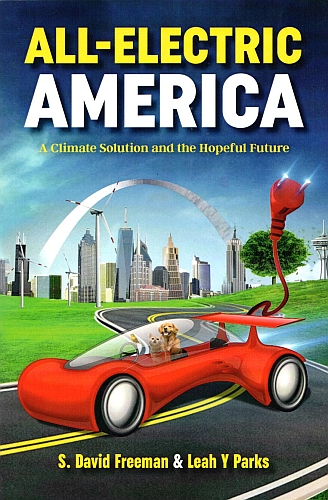

| ALL-ELECTRIC AMERICA A Climate Solution and the Hopeful Future S. David Freeman Leah Y. Parks Solar Flare Press, January 2016 |
Rating: 4.0 High |
|||
| ISBN-13 978-0-9961747-2-5 | ||||
| ISBN 0-9961747-2-9 | 223pp. | SC/BWI | $12.98 | |
Converting America to an energy infrastructure that uses no fossil fuels, or very little of them, has been urgent for a long time. The authors of this book are well-suited to advise us on how to go about making the changeover. S. David Freeman is a 40-year veteran of energy operations in executive positions with organizations like the Tennessee Valley Authority.1 Leah Y. Parks edits a professional journal for electricity-industry executives.2 They have a good handle on the technology, and they understand the history; they are aware that America has dealt with many challenges as formidable as climate change.
In the past, when this nation faced up to a deadly threat or an exciting challenge, we took action collectively. If it was poisonous, we outlawed it, as with DDT. If it saved lives, we mandated it, as with seat belts and airbags. And if it was a challenge, like going to the moon, we funded NASA to build a spaceship to get there. Greenhouse gases are our greatest challenge yet. We will only meet the challenge if the public demands vigorous action by our government now. – Pages 23-24 |
Writing in terms accessible to ordinary Americans, they describe the renewable-energy options that are available, focusing on solar and wind. They report on the current status of these options, that now are cost competitive in many areas of the country, and are becoming less expensive at rapid rates. Finally they present a plan that aims at cutting back U.S. emissions of greenhouse gases fast enough to keep the world under the 2°C threshold, a goal the world's scientists consider to be vitally necessary.
These authors go off the rails on nuclear power in several places. For example:
The "Atoms for Peace" program promised any nation that signed the treaty has the right to build atomic power plants with the condition that they do not make nuclear weapons. Unfortunately the fuel they need to power a power plant is everything they need to make a bomb. And with nations that we don't trust to keep their word we find that we promised the ingredients of war, not peace. American attempts to keep other nations and terrorists from obtaining atomic bombs have little credibility as long as America continues to promote atomic power plants for itself. The danger is not only a nuclear Iran but the availability of plutonium from reprocessing spent fuel and creating more plutonium—the fuel for the bombs. If even a small amount of plutonium gets into hands of groups like Al Queda and ISIS, for example, we could expect a disaster in a big city that would make 9/11 look like a traffic accident. And the only sure way to prevent it is for America, home of the so-called "Peaceful Atom," to declare atomic energy the very dangerous failure it is. – Pages 96-97 |
The language is excessively dramatic, and there are erroneous claims. One is that spent fuel is all you need to make a bomb. This is false. Even the simplest bomb, the so-called "dirty bomb" which uses chemical explosives to spread radioactives in a populated area, requires a good deal of equipment and entails considerable risk for the makers. Even if one were used, it would not equal the 9/11 attack. A fission bomb is far harder to make, and it needs facilities that only nations can afford.3 It is irresponsible to so exaggerate the risks of proliferation and minimize the obstacles to nuclear terrorism.
That plan is a radically ambitious one, and would certainly face stiff opposition from the special interests determined to stick with business as usual. The key question, of course, is whether it is a workable plan. Since the major obstacles to progress are political rather than technical, I judge that it could be helpful in speeding things along.
However, in my judgment the authors make a serious technical mistake: They categorically dismiss nuclear power. There are two things wrong with their thinking, in my opinion. First, they overlook the advantages of nuclear power and overemphasize the problems. Nothing can touch a nuclear power plant in terms of reliably generating large amounts of carbon-free power in a small area of land. Second, they label nuclear reactors of all types as inherently dangerous. More than 100 nuclear power plants have operated in this country for decades without killing anyone. Certainly nuclear power has its problems. What power source does not? But I continue to believe it can and should be one component of our energy system.
So I will recommend this book. It presents a lot of well-researched information, including descriptions of tools any homeowner can use, like the various kinds of heat pumps. It has extensive endnotes and a decent index. On the down side fall a relatively high number of grammatical and factual errors and, most regrettably, the authors' flawed analysis of nuclear power's place in America's energy system. Because of those defects, I mark it down two notches.

 To contact Chris Winter, send email to this address.
To contact Chris Winter, send email to this address.